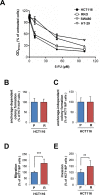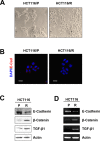Acquired resistance to 5-fluorouracil via HSP90/Src-mediated increase in thymidylate synthase expression in colon cancer
- PMID: 26416450
- PMCID: PMC4741717
- DOI: 10.18632/oncotarget.5327
Acquired resistance to 5-fluorouracil via HSP90/Src-mediated increase in thymidylate synthase expression in colon cancer
Abstract
5-fluorouracil (5-FU), one of the first-line chemotherapeutic agents for the treatment of gastrointestinal malignancies, has shown limited efficacy. The expression of thymidylate synthase (TYMS) has been reported to be associated with the resistance to 5-FU. Here, we demonstrate that the enhanced HSP90 function and subsequent activation of Src induce expression of TYMS and acquired resistance to 5-FU in colon cancer. We show that the persistent 5-FU treatment granted 5-FU-sensitive HCT116 colon cancer cells morphologic, molecular, and behavioral characteristic of the epithelial-mesenchymal transition (EMT), contributing to emergence of acquired resistance to 5-FU. HCT116/R, a HCT116 colon cancer cell subline carrying acquired resistance to 5-FU, showed increased expression and activation of HSP90's client proteins and transcriptional up-regulation of TYMS. Forced overexpression of HSP90 or constitutive active Src in HCT116 cells increased TYMS expression. Conversely, pharmacological blockade of HSP90 or Src in HCT116/R cells effectively suppressed the changes involved in 5-FU resistance in vitro and xenograft tumor growth, hematogenous spread, and metastatic tumor development in vivo. This study suggests a novel function of HSP90-Src pathway in regulation of TYMS expression and acquisition of 5-FU resistance. Thus, therapeutics targeting this pathway may be an effective clinical strategy to overcome 5-FU resistance in colon cancer.
Keywords: 5-fluorouracil; HSP90; Src; colon cancer.
Conflict of interest statement
The authors declare that there are no conflicts of interest.
Figures






References
-
- Longley DB, Harkin DP, Johnston PG. 5-fluorouracil: mechanisms of action and clinical strategies. Nature reviews Cancer. 2003;3:330–338. - PubMed
-
- Tabernero J, Van Cutsem E, Diaz-Rubio E, Cervantes A, Humblet Y, Andre T, Van Laethem JL, Soulie P, Casado E, Verslype C, Valera JS, Tortora G, Ciardiello F, et al. Phase II trial of cetuximab in combination with fluorouracil, leucovorin, and oxaliplatin in the first-line treatment of metastatic colorectal cancer. Journal of clinical oncology : official journal of the American Society of Clinical Oncology. 2007;25:5225–5232. - PubMed
-
- Koizumi W, Kurihara M, Sasai T, Yoshida S, Morise K, Imamura A, Akazawa S, Betsuyaku T, Ohkubo S, Takahashi H, et al. A phase II study of combination therapy with 5′-deoxy-5-fluorouridine and cisplatin in the treatment of advanced gastric cancer with primary foci. Cancer. 1993;72:658–662. - PubMed
-
- Bleiberg H, de Gramont A. Oxaliplatin plus 5-fluorouracil: clinical experience in patients with advanced colorectal cancer. Seminars in oncology. 1998;25:32–39. - PubMed
Publication types
MeSH terms
Substances
LinkOut - more resources
Full Text Sources
Other Literature Sources
Miscellaneous

